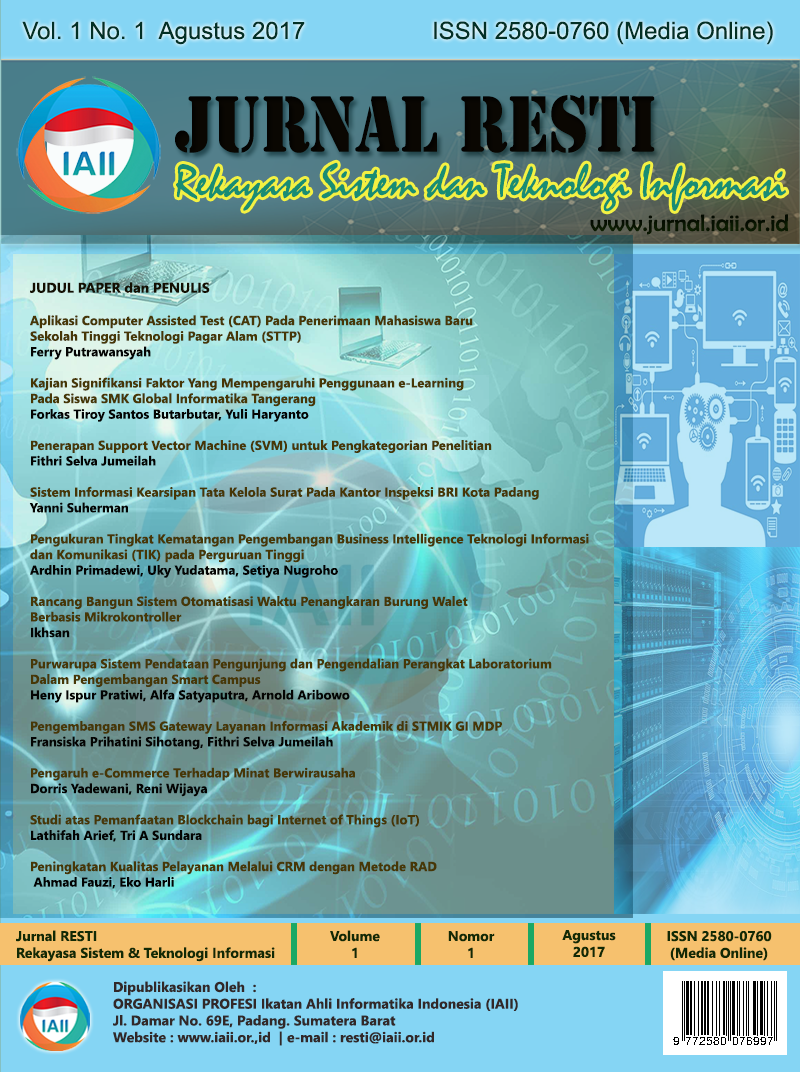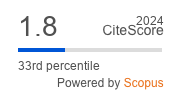Pengukuran Tingkat Kematangan Pengembangan Business Intelligence Teknologi Informasi dan Komunikasi (TIK) pada Perguruan Tinggi
Abstract
In the era of globalization, the role of Information and Communication Technology (ICT) is the main asset in winning the global competition. Currently the role of ICT in education is enormous. High education have used ICT as an implementation of e-business. But the implementation of ICT business intelligence in high education still sporadic. High education need direction of measurable and targeted ICT development with business intelligence overview. It needs a reference of management and monitoring of ICT business intelligence implementation at high education as a benchmark. The benchmark in this study is using BIDM framework that can evaluate the development of business intelligence implementation from technological, human and process perspective. The result is a level in terms of implementation of ICT business intelligence in high education that became the basis of making the next strategic plan of higher education. Then the existing problems can be mapped using Value chain analysis. Combining these two ways is expected to be a reference for the development of implementation of ICT business intelligence in high education to be more systematic.
Downloads
References
[2] A. Setiawan, 2009, “Evaluasi penerapan teknologi informasi di perguruan tinggi swasta Yogyakarta dengan menggunakan model Cobit framework,†in : Seminar Nasional Aplikasi Teknologi Informasi (SNATI), p. A-15.
[3] J. Raya and P. Cina, 2012, “TEKNOLOGI INFORMASI DAN KOMUNIKASI (TIK) UNTUK KETAHANAN NASIONAL,†in : PROSIDING KOMPUTER DAN SISTEM INTELIJEN.
[4] P. Rani and D. Rahmawati, 2008, “Analisis Penerapan e-business studi kasus pada PT, Sinar Mas Agro Resources and Technology (SMART) Tbk,†J. Pendidik. Akunt. Indones., vol. 6, no. 2, pp. 52–59.
[5] S. Warnars, 2008, “Rancangan Infrastruktur E- Bisnis Business Intelligence pada Perguruan Tinggi,†Telkomnika, vol. 6, p. 6930.
[6] M. Budiarto, Maimunah, and R. Andrian, 2012, “Perancangan Infrastruktur E-Bisnis Business Intelligence Pada Perguruan Tinggi,†CSRID J., vol. 4, no. 1, pp. 50–62.
[7] I. Silanegara, B. Tama, and D. Nurhidayat, 2013, “Perencanaan Strategis Teknologi Informasi (Studi Kasus: Politeknik Negeri Jakarta),†J. Generic, vol. 6, no. 1, pp. 13–18.
[8] N. K. S. Putri, Hudiarto, Argogalih, and H. Muljoredjo, 2014, “The use of green information technology governance model to determine capability maturity level in DKI Jakarta private higher education institutions,†J. Theor. Appl. Inf. Technol., vol. 61, no. 1, pp. 10–16.
[9] N. Putri, Hudiarto, Argogalih, and H. Muljoredjo, 2014, “THE USE OF GREEN INFORMATION TECHNOLOGY GOVERNANCE MODEL TO DETERMINE CAPABILITY MATURITY LEVEL IN DKI JAKARTA PRIVATE HIGHER,†J. Theor., vol. 61, no. 1, pp. 10–16.
[10] M. A. Firdaus, A. Putra, and D. R. Indah, 2013, “Analisis Business Intelligence pada Pengelolaan Data Alumni: Upaya Mendukung Monitoring Kualitas Alumni di Perguruan Tinggi (Studi Kasus di Fakultas Ilmu,†J. Generic, vol. 8, no. 2, pp. 221–229.
[11] S. Romayah, A. Suroso, and A. Ramadhan, 2014, “Evaluasi Implementasi E-government di Instansi XYZ,†J. Apl. Manaj., vol. 12, no. 4, pp. 612–620.
[12] A. Authoni and E. Suryani, 2014, “Purwarupa Performance Dashboard Untuk Membantu Analisis Data Evaluasi Diri Perguruan Tinggi (PT) Berdasarkan Key Performance Indikators (KPI) Studi,†in : Prosiding Seminar Nasional Manajemen Teknologi XXI, p. C-1-1.
[13] A. Hidayanto, Y. Ahmadin, and M. Jiwanggi, 2010, “Pengukuran Tingkat Dukungan Teknologi Informasi Pada Direktorat Transformasi Teknologi Komunikasi Dan Informasi, Direktorat Jenderal Pajak Dengan,†J. Sist. Inf., vol. 6, no. 2, pp. 117–125.
[14] W. W. Eckerson, “Business intelligence maturity model,†Tdwi, 2005. [Online]. Available: http://www.eurim.org.uk/activities/ig/voi/03-01-06_Executive_Series_Assessing_Your_BI_Maturity.pdf.
[15] S. P. Adithama, I. Wisnubhadra, and B. L. Sinaga, 2013, “Analisis Dan Desain Real-Time Business Intelligence Menggunakan Change Data Capture,†in : Semin. Nas. Teknol. Inf. dan Komun. 2013 (SENTIKA 2013), vol. 2013, no. Bisnis Intelligent, pp. 1–9.
[16] R. Yunis and K. Surendro, 2010, “Implementasi Enterprise Architecture Perguruan Tinggi,†in : Seminar Nasional Aplikasi Teknologi Informasi, , p. A-51.
[17] E. U. Artha, E. Utami, and E. Boedijanto, 2012, “Ishikawa Pada Bagian Umum Kanreg I Badan,†J. Teknol. Inf., vol. 20.
[18] C. Sacu and M. Spruit, 2010, “BIDM-The Business Intelligence Development Model.,†Inst. Inf. Comput. Sci., vol. 1.
[19] N. Foshay, W. Yeoh, Y. Boo, K. Ong, and D. Mattie, 2015, “A comprehensive diagnostic framework for evaluating business intelligence and analytics effectiveness,†Australas. J. Inf. Syst., vol. 19, no. 1, pp. S37–S54.
[20] F. Halper and K. Krishnan, “TDWI Big Data Maturity Model Guide,†TDWI Benchmark Guide, 2014. [Online]. Available: https://pdfs.semanticscholar.org/6771/d16bb3d5da49be697f73ed2e1ef4fb7a6e51.pdf. [Accessed: 19-Apr-2017].
[21] M.-H. Chuah and K.-L. Wong, 2011, “A review of business intelligence and its maturity models,†African J. Bus. Manag., vol. 5, no. 9, pp. 3424–3428.
[22] M. Chuah and K. Wong, 2013, “The Implementation of Enterprise Business Intelligence: Case Study Approach,†J. Southeast Asian Res.
[23] M. Chuah and K. Wong, 2013, “Enterprise Business Intelligence Maturity Model: Case Study in Financial Industry,†J. Southeast Asian Res.
[24] J. W. and J. Peppard., 2002, Strategic Planning for Information System 3nd ed. England : John Wiley & Sons.
Copyright (c) 2017 Jurnal RESTI (Rekayasa Sistem dan Teknologi Informasi)

This work is licensed under a Creative Commons Attribution 4.0 International License.
Copyright in each article belongs to the author
- The author acknowledges that the RESTI Journal (System Engineering and Information Technology) is the first publisher to publish with a license Creative Commons Attribution 4.0 International License.
- Authors can enter writing separately, arrange the non-exclusive distribution of manuscripts that have been published in this journal into other versions (eg sent to the author's institutional repository, publication in a book, etc.), by acknowledging that the manuscript has been published for the first time in the RESTI (Rekayasa Sistem dan Teknologi Informasi) journal ;








